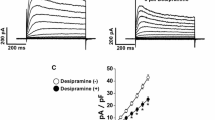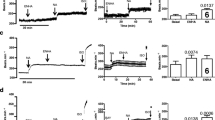Summary
-
1.
A model of a competitive antagonism in which the agonist is subject to saturable uptake was developed in two variants: homogeneous and inhomogeneous distribution of the agonist in the extracellular space of an isolated tissue.
-
2.
The predicted changes in the relation of the slope to the position of the concentration-effect curves were compared with the changes found during the positive inotropic action of (±)-isoprenaline and (−)-noradrenaline on guinea-pig papillary muscles. With (±)-isoprenaline a slight increase in slope was detected together with the shift caused by (±)-propranolol. With (−)-noradrenaline the slope increased and then decreased as the (±)-propranolol concentration rose.
-
3.
The influence of the negative inotropic effect of high concentrations of (±)-propranolol (≥3×10−6 mol/l) was estimated with (+)-propranolol.
-
4.
On preparations from reserpine-pretreated animals a biphasic change in the relation of slope to EC50 of the concentration-effect curves of (−)-noradrenaline was found with cocaine. This finding was not consistent with a simple competitive inhibition of an uptake mechanism which reduces the concentration of (−)-noradrenaline near freely accessible β-adrenoceptors.
-
5.
On papillary muscle from reserpine-pretreated animals exposed to 2×10−5 mol/l cocaine (±)-propranolol reduced the slope of the (−)-noradrenaline concentration-effect curve with the shift to the right.
-
6.
The “homogeneity” model was used in the statistical evaluation of the parameters of saturable uptake and competitive antagonism from the experimental data. The assumption of saturable uptake of (±)-isoprenaline significantly improved the goodness of fit in comparison to a pure competitive antagonism without uptake, but, with (−)-noradrenaline as agonist, a higher (±)-propranolol-receptor dissociation constant K B was obtained than with (±)-isoprenaline. The expansion of the model to include an uptakeinhibiting effect of (±)-propranolol significantly improved the goodness of fit.
-
7.
The K B of (+)-propranolol was about 1/100 the K B of the racemate.
-
8.
The model of saturable uptake with competitive antagonism at freely accessible β-adrenoceptors is compatible with the effects of (±)-isoprenaline, but not those of (−)-noradrenaline.
Similar content being viewed by others
References
Arunlakshana O, Schild HO (1959) Some quantitative uses of drug antagonists. Br J Pharmacol 14:48–58
Azevedo I, Osswald W (1976) Uptake, distribution and metabolism of isoprenaline in the dog saphenous vein. Naunyn-Schmiedeberg's Arch Pharmacol 295:141–147
Blinks JR (1967) Evaluation of the cardiac effects of several beta adrenergic blocking agents. Ann NY Acad Sci 139:673–685
Bönisch H, Trendelenburg U (1974) Extraneuronal removal, accumulation and O-methylation of isoprenaline in the perfused heart. Naunyn-Schmiedeberg's Arch Pharmacol 283:191–218
Bönisch H, Uhlig W, Trendelenburg U (1974) Analysis of the compartments involved in the extraneuronal storage and metabolism of isoprenaline in the perfused heart. Naunyn-Schmiedeberg's Arch Pharmacol 283:223–244
Brandt W, Reiter M, Seibel K (1972) “Supramaximal” enhancement of the inotropic effect of noradrenaline by tyramine. Naunyn-Schmiedeberg's Arch Pharmacol 273:294–306
Brown EM, Fedak SA, Woodard ChJ, Aurbach GD, Rodbard D (1976) β-Adrenergic interactions. Direct comparison of receptor interaction and biological activity. J Biol Chem 251:1239–1246
Callingham BA, Burgen ASV (1966) The uptake of isoprenaline and noradrenaline by the perfused rat heart. Mol Pharmacol 2:37–42
Ebner F (1979) Simultaneous estimation of antagonistic potency and uptake parameters in β-adrenoceptor blockade. Naunyn-Schmiedeberg's Arch Pharmacol 307:R39
Ebner F (1981) The positive inotropic effect of (−)-noradrenaline and (±)-isoprenaline after chemical sympathectomy: Evidence in favour of differences at a postsynaptic site. Naunyn-Schmiedeberg's Arch Pharmacol 316:8–18
Ebner F, Waud DR (1978) The role of uptake of noradrenaline for its positive inotropic effect in relation to muscle geometry. Statistical evaluation. Naunyn-Schmiedeberg's Arch Pharmacol 303:1–6
Foo JW, Jowett A, Stafford A (1968) The effects of some β-adrenoceptor blocking drugs on the uptake and release of noradrenaline by the heart. Br J Pharmacol 34:141–147
Furchgott RF (1972) The classification of adrenoceptors (adrenergic receptors). An evaluation from the standpoint of receptor theory. In: Blaschko H, Muscholl E (eds) Catecholamines, Springer Berlin Heidelberg New York, pp. 283–335
Graefe K-H, Bönisch H, Keller B (1978) Saturation kinetics of the adrenergic uptake system in the perfused rabbit heart. A new method for determination of initial rates of amine uptake. Naunyn-Schmiedeberg's Arch Pharmacol 302:263–273
Iversen LL (1963) The uptake of noradrenaline by the isolated perfused rat heart. Br J Pharmacol 21:523–537
Kaumann AJ, Birnbaumer L (1974) Studies on receptor-mediated activation of adenyl cyclase. IV. Characteristics of the adrenergic receptor coupled to myocardial adenylyl cyclase: stereospecificity for ligands and determination of apparent affinity constants for β-blockers. J Biol Chem 249:7874–7885
Krawietz W, Poppert D, Erdmann E, Glossmann H, Struck CJ, Konrad C (1976) β-Adrenergic receptors in guinea-pig myocardial tissue. Naunyn-Schmiedeberg's Arch Pharmacol 295:215–224
Langer SZ, Trendelenburg U (1969) The effect of saturable uptake mechanism on the slopes of dose-response curves for sympathomimetic amines and on the shifts of dose-response curves produced by a competitive antagonist. J Pharmacol Exp Ther 167:117–142
Parker RB, Waud DR (1971) Pharmacological estimation of drugreceptor dissociation constants. Statistical evaluation. I. Agonists. J Pharmacol Exp Ther 177:1–12
Thron CD (1973) On the analysis of pharmacological experiments in terms of an allosteric receptor model. Mol Pharmacol 9:1–9
Waud DR (1975) Analysis of dose-response curves. In: Daniel EE, Paton DM (eds) Methods in pharmacology, vol 3, Smooth muscle. Plenum Press, New York London, pp 471–506
Waud DR, Parker RB (1971) Pharmacological estimation of drugreceptor dissociation constants. Statistical evaluation. II. Competitive antagonists. J Pharmacol Exp Ther 177:13–24
Young DAB (1968) Factors controlling the washout of the interstitial space of the isolated perfused heart. J Physiol (Lond) 196:747–759
Author information
Authors and Affiliations
Rights and permissions
About this article
Cite this article
Ebner, F. The inhibition by (±)-propranolol of the positive inotropic effects of (±)-isoprenaline and (−)-noradrenaline. Naunyn-Schmiedeberg's Arch. Pharmacol. 316, 96–107 (1981). https://doi.org/10.1007/BF00505301
Received:
Accepted:
Issue Date:
DOI: https://doi.org/10.1007/BF00505301




